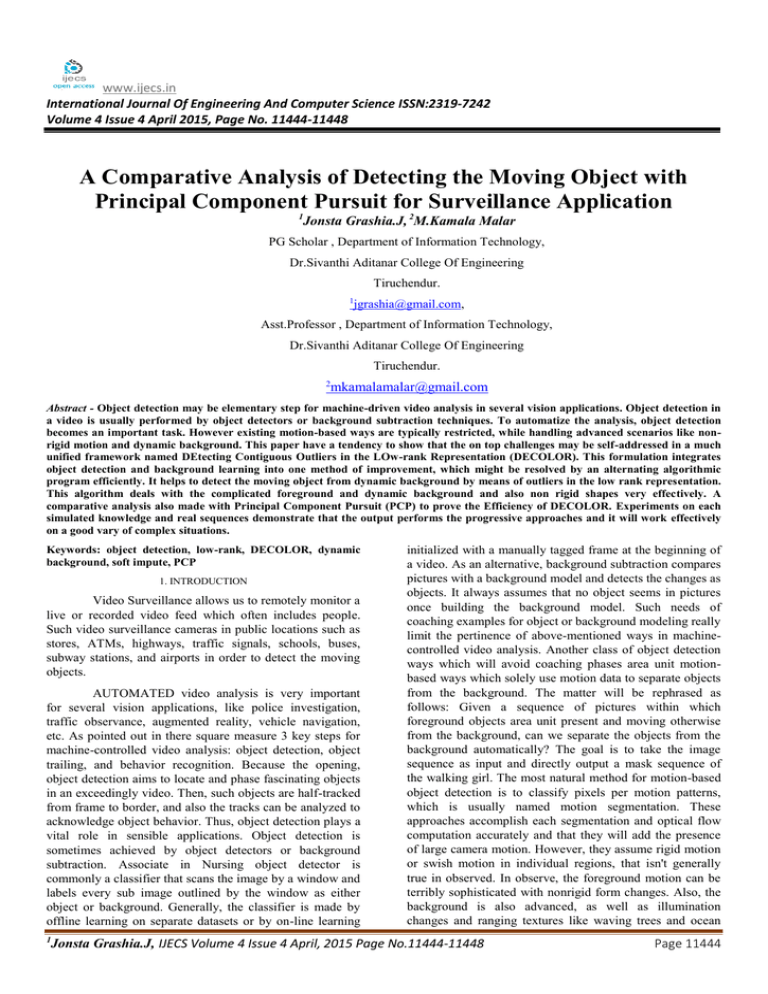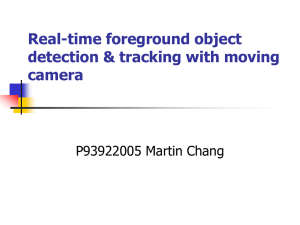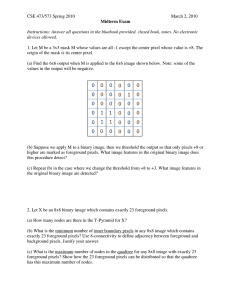www.ijecs.in International Journal Of Engineering And Computer Science ISSN:2319-7242
advertisement

www.ijecs.in International Journal Of Engineering And Computer Science ISSN:2319-7242 Volume 4 Issue 4 April 2015, Page No. 11444-11448 A Comparative Analysis of Detecting the Moving Object with Principal Component Pursuit for Surveillance Application 1 Jonsta Grashia.J, 2M.Kamala Malar PG Scholar , Department of Information Technology, Dr.Sivanthi Aditanar College Of Engineering Tiruchendur. 1 jgrashia@gmail.com, Asst.Professor , Department of Information Technology, Dr.Sivanthi Aditanar College Of Engineering Tiruchendur. 2 mkamalamalar@gmail.com Abstract - Object detection may be elementary step for machine-driven video analysis in several vision applications. Object detection in a video is usually performed by object detectors or background subtraction techniques. To automatize the analysis, object detection becomes an important task. However existing motion-based ways are typically restricted, while handling advanced scenarios like nonrigid motion and dynamic background. This paper have a tendency to show that the on top challenges may be self-addressed in a much unified framework named DEtecting Contiguous Outliers in the LOw-rank Representation (DECOLOR). This formulation integrates object detection and background learning into one method of improvement, which might be resolved by an alternating algorithmic program efficiently. It helps to detect the moving object from dynamic background by means of outliers in the low rank representation. This algorithm deals with the complicated foreground and dynamic background and also non rigid shapes very effectively. A comparative analysis also made with Principal Component Pursuit (PCP) to prove the Efficiency of DECOLOR. Experiments on each simulated knowledge and real sequences demonstrate that the output performs the progressive approaches and it will work effectively on a good vary of complex situations. Keywords: object detection, low-rank, DECOLOR, dynamic background, soft impute, PCP 1. INTRODUCTION Video Surveillance allows us to remotely monitor a live or recorded video feed which often includes people. Such video surveillance cameras in public locations such as stores, ATMs, highways, traffic signals, schools, buses, subway stations, and airports in order to detect the moving objects. AUTOMATED video analysis is very important for several vision applications, like police investigation, traffic observance, augmented reality, vehicle navigation, etc. As pointed out in there square measure 3 key steps for machine-controlled video analysis: object detection, object trailing, and behavior recognition. Because the opening, object detection aims to locate and phase fascinating objects in an exceedingly video. Then, such objects are half-tracked from frame to border, and also the tracks can be analyzed to acknowledge object behavior. Thus, object detection plays a vital role in sensible applications. Object detection is sometimes achieved by object detectors or background subtraction. Associate in Nursing object detector is commonly a classifier that scans the image by a window and labels every sub image outlined by the window as either object or background. Generally, the classifier is made by offline learning on separate datasets or by on-line learning 1 initialized with a manually tagged frame at the beginning of a video. As an alternative, background subtraction compares pictures with a background model and detects the changes as objects. It always assumes that no object seems in pictures once building the background model. Such needs of coaching examples for object or background modeling really limit the pertinence of above-mentioned ways in machinecontrolled video analysis. Another class of object detection ways which will avoid coaching phases area unit motionbased ways which solely use motion data to separate objects from the background. The matter will be rephrased as follows: Given a sequence of pictures within which foreground objects area unit present and moving otherwise from the background, can we separate the objects from the background automatically? The goal is to take the image sequence as input and directly output a mask sequence of the walking girl. The most natural method for motion-based object detection is to classify pixels per motion patterns, which is usually named motion segmentation. These approaches accomplish each segmentation and optical flow computation accurately and that they will add the presence of large camera motion. However, they assume rigid motion or swish motion in individual regions, that isn't generally true in observed. In observe, the foreground motion can be terribly sophisticated with nonrigid form changes. Also, the background is also advanced, as well as illumination changes and ranging textures like waving trees and ocean Jonsta Grashia.J, IJECS Volume 4 Issue 4 April, 2015 Page No.11444-11448 Page 11444 waves. The video includes Associate in nursing operational escalator; however it ought to be thought to be background for human trailing purpose. An alternate motion-based approach is background estimation. Different from background subtraction, it estimates a background model directly from the testing sequence. Generally, it tries to hunt temporal intervals within that the pixel intensity is unchanged and uses image knowledge from such intervals for background estimation. However, this approach additionally depends on the idea of static background. Hence, it's tough to handle the situations with advanced background or moving cameras. 2. OBJECTIVE Moving object detection, which is a fundamental step for automated video analysis in many vision applications. A framework named “DEtecting Contiguous Outliers in the LOw-rank Representation” (DECOLOR), where the background is approximated by a low-rank matrix and foreground objects can be detected as outliers. Outlier detection allows us to get rid of many assumptions on the behavior of foreground. The low-rank representation of background makes it flexible to accommodate the global variations in the background. With the help of motion camera, the video is taken as the input to detect the moving object from the dynamic background. The main purpose of this process is for surveillance application. To overcome the problems in existing system, propose a novel algorithm for moving object detection which falls into the category of motion based methods. It solves the challenges which the existing algorithm couldn’t which is a unified framework named DEtecting Contiguous Outliers in the LOw-rank Representation (DECOLOR). This formulation integrates object detection and background learning into a single process of optimization. This algorithm deals with the complicated foreground and dynamic background and also non rigid shapes very effectively. Background images are linearly correlated. Thus, the matrix composed of vectorized video frames can be approximated by a low-rank matrix, and the moving objects can be detected as outliers in this low-rank representation. Outlier detection allows us to get rid of many assumptions on the behavior of foreground. The low-rank representation of background makes it flexible to accommodate the global variations in the background . Moreover, DECOLOR performs object detection and background estimation simultaneously without training sequences. Advantages Very efficient Low memory management Less power consumption Low maintenance 3. PROBLEM DESCRIPTION To automate the analysis, object detection without a separate training phase becomes a critical task. People have tried to tackle this task by using motion information. But existing motion based methods are usually limited when coping with complex scenarios such as nonrigid motion and dynamic background. 5. SYSTEM DESIGN A. System Architecture For this reason a framework named “DEtecting Contiguous Outliers in the LOw-rank Representation” (DECOLOR) which deals with the complicated background including illumination changes and varying textures (waving trees and sea waves) and also nonrigid shapes for the moving cameras. 4. SYSTEM ANALYSIS A. Existing System In this paper the existing motion based method is sparsity -based methods. These methods are usually deals with static cameras and applicable for object detection with static background. The methods used for foreground detection are they undergo object detectors (supervised learning), image segmentation, background subtraction, etc. The problems in these methods are they are not applicable for the scenario like nonrigid motion and dynamic background (complicated). Limitations Less efficiency. Only possible for comparison. Fig.1. System Architecture 6. PROPOSED METHOD DESCRIPTION A. Identification of foreground and background For the input video sequence which is taken from the moving camera, have to identify the foreground and background. Because have to differentiate in order to detect the moving foreground object. This can be estimated using the following process. Lacks computation capability while monitoring. Does not keep track of previous surveillance operations. (1) Sij= B. Proposed System 1 Jonsta Grashia.J, IJECS Volume 4 Issue 4 April, 2015 Page No.11444-11448 Page 11445 The ith pixel in the jth frame is denoted as ij. Background model: The background intensity should be unchanged over the sequence except for variations arising from illumination change or periodical motion of dynamic textures. Foreground model: The foreground is defined as any object that moves differently from the background. B. Construction of Low Rank Matrix The background intensity should be unchanged over the sequence except for variations arising from illumination change or periodical motion of dynamic textures. Thus, background images are linearly correlated with each other, forming a low-rank matrix. It fits only the observed sequence. So when the moving object is introduced in the scene there is a changes occurred in the background model. The result of these changes made the pixels loses in the low rank matrix. In order to fill the mixing values of low rank matrix an algorithm called SOFT IMPUTE was used. The SOFT IMPUTE algorithm is used to fill the missing values iteratively. Iterative methods matrix completion that use nuclear-norm regularization. There are two main approaches. The one approach uses iterative softthreshold svds to impute the missing values. The second approach uses alternating least squares. Both have an ”EM'' flavor, in that at each iteration the matrix is completed with the current estimate. For large matrices there is a special sparse-matrix class named ``Incomplete'' that efficiently handles all computations. The package includes procedures for centering and scaling rows, columns or both. 1. Initialize Zold = 0. 2. Do for λ1> λ2>…> λk (a) Repeat: i. Compute Znew S λk (PΩ(X) + P ( Zold )). when they are interacting, e.g. two people stopping and talking to each other and then shaking hands or hugging before departure. People may also be moving in groups or form and leave groups in an arbitrary fashion. These challenges could be solved by restricting the movement of the objects, but this would limit the system from being applied in many situations. Different types of objects: In some open areas many different types of objects will be present. A surveillance video of a parking lot for example will contain vehicles, persons, and maybe birds or dogs. People may also leave or pick up other objects in the scene. The most general surveillance system would be able to distinguish between these objects, and treat them in the way most appropriate to that type of object. Constraints in this respect would limit the system to areas with only a certain type of objects. Foreground motion gives intensity changes that cannot be fitted into the low-rank model of background. Thus, they can be detected as outliers in the low-rank representation. To detect the moving object as the outliers, the motion segmentation should be carried. The motion segmentation and outlier detection are carried out using the proposed algorithm knows as DEtecting Contiguous Outliers in the LOw-rank Representation (DECOLOR). DECOLOR aims to segment moving objects from a short sequence during which the objects continuously appear, which is a more challenging problem. To this end, DECOLOR estimates the foreground and background jointly by outlier detection during matrix learning. DECOLOR recovers the background and outputs a foreground mask accurately. Motion Segmentation classifies pixels according to motion patterns. The most natural method for motion-based object detection is to classify pixels per motion patterns, which is usually named motion segmentation. 1. Input: D = [ I1,…, In ]ϵ IRmxn Dο 2. Initialize: ii. If iii. Assign Zold < exit. Znew . O , α , β. 3. repeat 4. ∆τ ∆τ ) || PŜ ; 5. repeat (b) 3. Assign Ẑλk Znew Output the sequence of solutions Ẑλ ,………, Ẑλk C. Detecting Contiguous Outliers in the Low-Rank Representation. In an open area the objects will be able to move in any direction, and with a camera setup typical of surveillance systems, this will give movement in all directions of the surveillance video, and objects will enter and leave the field of view on all its boundaries. Furthermore the video will show some perspective, i.e. the size of an object will change when it moves towards or away from the camera. The objects’ freedom of movement also implies that they can move in a way where they occlude each other, or they may stop moving for a while. In the case of people the occlusion and stopping will be very likely 1 6. α( PŜ PŜ ( 7. Until Convergence 8. If rank ( ≤ K then 9. α ←η1α 10. go to step 5 11. End if 12. Estimate ; 13. 2 2 14. Ŝ← arg mins ij ( ); β- ([ D ο ij - ij )2 ) Sij + γ || A vec (S)||1 15. Until Convergence 16. Output : Jonsta Grashia.J, IJECS Volume 4 Issue 4 April, 2015 Page No.11444-11448 Page 11446 After the motion segmentation the foreground object is detected as outliers. An outlier is an observation that appears to deviate markedly from other observations. Outlier detection allows us to get rid of many assumptions on the behavior of foreground. DECOLOR can align the images, learn a background model, and detect objects correctly. progressive approaches and it will work effectively on a good vary of complex situations. The comparative analysis also made with Principal Component Analysis (PCP) and the results are compared. D. Foreground Detection Each frame is subtracted by the background image and the difference is threshold to generate the foreground mask. The final foreground object is estimated by subtracting the background model. The moving foreground object mask is the output which is used for surveillance application. (a) (b) E. Principal Component Pursuit (PCP) Principal Component Pursuit (PCP) is a convex program which recovers the low rank model from unknown corrupted data and also promising potential for background subtraction. The data matrix M which is decomposed into S (foreground) and L (background). M=S+L (2) (c) (d) Fig. 2. Women walking in the street L is estimated using singular value thresholding (SVT). SVT algorithm for matrix completion. This algorithm computes the missing elements of a matrix. So that the resultant matrix is an approximate of the completion with the least rank. S is estimated using softshinkage operator which is to minimize the foreground image according to its shape. This way it recovers the Low rank model and foreground. F. Compare DECOLOR with PCP To prove the efficiency of the proposed method DECOLOR, which is compare with PCP. Both DECOLOR and PCP aims to recover a low rank model from the corrupted data (a ) ( b) The Input is synthesized data composed of 50 frames. Here S0 is foreground support and B0 is Background images. The model D is generated by adding a foreground object. After Gaussian noise is added to each entry and the signal to noise ratio is calculated. The result is denoted by Ŝ as Foreground and as Background .The accuracy of foreground is calculated by FMeasure (combination of precision and recall) .The accuracy of background is calculated by Root Mean Square Error. The result gives that PCP is not Robust enough when the moving objects takes up relatively large and contiguous space of the sequence. DECOLOR is Robust enough gives a stable performance for outlier detection, the accuracy of matrix of recovery and maintains the better performance. DECOLOR uses non convex penalty that are more greedy to detect outlier regions which is relatively dense and contiguous. Thus DECOLOR recovers the background and foreground mask accurately. (c) (d) Fig 3: Driving a car (a)Input video (b) low rank (c) Moving object segmentation (d) foreground detection 7. EXPERIMENTAL RESULTS Experiments on each simulated knowledge and real sequences demonstrate that the output performs the 1 Jonsta Grashia.J, IJECS Volume 4 Issue 4 April, 2015 Page No.11444-11448 Page 11447 REFERENCES [1] Xiaowei Zhou , Can Yang, and Weichuan Yu “ Moving Fig.4. Principal Component Pursuit (PCP) Fig.5. DECOLOR Comparing the figure 4 and figure 5 shows that the DECOLOR gives accurate detection of foreground and recovery of background which is better than Principal Component Pursuit (PCP). 8. CONCLUSION In this paper, propose a novel framework named DECOLOR to segment moving objects from image sequences. It avoids complicated motion computation by formulating the problem as outlier detection and makes use of the low-rank modeling to deal with complex background. DECOLOR uses the nonconvex penalty for outlier detection, which is more greedy to detect outlier regions that are relatively dense and contiguous. The comparative analysis also made with PCP, that proves the efficiency of DECOLOR. ACKNOWLEDGEMENT object detection by Detecting Contiguous outliers in the Low-Rank Representation” IEEE transactions on pattern analysis and machine intelligence, vol. 35, no. 3, march 2013 [2] T. Matsuyama, T. Ohya, and H. Habe, “Background Subtraction for Non-Stationary Scenes,” Proc. Asian Conf. Computer Vision, 2000. [3] K. Kim, T. Chalidabhongse, D. Harwood, and L. Davis, “Real- Time Foreground-Background Segmentation Using Codebook Model,” Real-Time Imaging, vol. 11, no. 3, pp. 172-185, 2005. [4] N. Friedman and S. Russell, “Image Segmentation in Video Sequences: A Probabilistic Approach,” Proc. Conf. Uncertainty in Artificial Intelligence, 1997. [5] J. Rittscher, J. Kato, S. Joga, and A. Blake, “A Probabilistic Background Model for Tracking,” Proc. European Conf. Computer Vision, 2000. [6] A. Monnet, A. Mittal, N. Paragios, and V. Ramesh, “Background Modeling and Subtraction of Dynamic Scenes,” Proc. IEEE Int’l Conf. Computer Vision, 2003. [7] J. Zhong and S. Sclaroff, “Segmenting Foreground Objects from a Dynamic Textured Background via a Robust Kalman Filter,” Proc.IEEE Int’l Conf. Computer Vision, 2003. [8] J. Wright, Y. Ma, J. Mairal, G. Sapiro, T. Huang, and S. Yan, “Sparse Representation for Computer Vision and Pattern Recognition,” Proc. IEEE, vol. 98, no. 6, pp. 1031-1044, June 2010. [9] N. Oliver, B. Rosario, and A. Pentland, “A Bayesian Computer Vision System for Modeling Human Interactions,” IEEE Trans. Pattern Analysis and Machine Intelligence, vol. 22, no. 8, pp. 831-843, Aug. 2000. [10] V. Cevher, M. Duarte, C. Hegde, and R. Baraniuk, “Sparse Signal Recovery Using Markov Random Fields,” Proc. Advances in Neural Information and Processing Systems, 2008. [11] J. Huang, X. Huang, and D. Metaxas, “Learning with Dynamic Group Sparsity,” Proc. IEEE Int’l Conf. Computer Vision, 2009. [12] J. Mairal, R. Jenatton, G. Obozinski, and F. Bach, “Network Flow Algorithms for Structured Sparsity,” Proc. Advances in Neural Information and Processing Systems, 2010. [13] H. Wang and D. Suter, “A Novel Robust Statistical Method for Background Initialization and Visual Surveillance,” Proc. Asian Conf. Computer Vision, 2006. [14] S. Geman and D. Geman, “Stochastic Relaxation, Gibbs Distributions, and the Bayesian Restoration of Images,” IEEE Trans. Pattern Analysis and Machine Intelligence, vol. 6, no. 6, pp. 721-741, Nov.1984. [15] B. Recht, M. Fazel, and P. Parrilo, “Guaranteed MinimumRank Solutions of Linear Matrix Equations via Nuclear Norm Minimization,” SIAM Rev., vol. 52, no. 3, pp. 471501, 2010. [16] R. Mazumder, T. Hastie, and R. Tibshirani, “Spectral Regularization Algorithms for Learning Large Incomplete Matrices, J. Machine Learning Research, vol. 11, pp. 22872322, 2010. [17] J. Cai, E. Cande`s, and Z. Shen, “A Singular Value Thresholding Algorithm for Matrix Completion,” SIAM J. Optimization, vol. 20, pp. 1956-1982, 2010. [18] Y. Boykov, O. Veksler, and R. Zabih, “Fast Approximate Energy Minimization via Graph Cuts,” IEEE Trans. Pattern Analysis and Machine Intelligence, vol. 23, no. 11, pp. 1222-1239, Nov. 2001. My sincere thanks to Ms.M.Kamala Malar Asst.Professor/IT for her innovative ideas and suggestions throughout my project for the successful completion of my project. 1 Jonsta Grashia.J, IJECS Volume 4 Issue 4 April, 2015 Page No.11444-11448 Page 11448


![[#SERVER-356] puppetserver foreground produces no output](http://s3.studylib.net/store/data/007272558_1-0b519497a4c38f6e1e2ba67cc009a68c-300x300.png)


